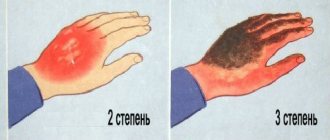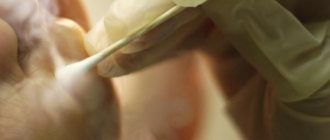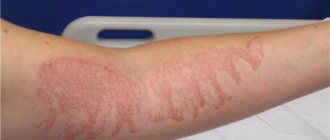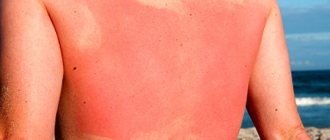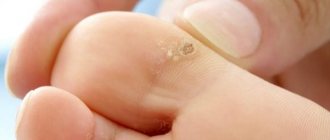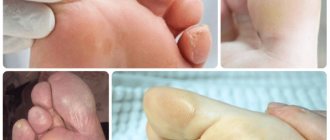Causes
Iodine is a highly concentrated alcohol solution, which, if used incorrectly, can cause a burn to the surface being treated.
For medical purposes, it is used as an antiseptic to treat affected skin.
Iodine burn can occur when:
- Large quantities and area of application.
- Processing that continues beyond the permitted period.
- Penetration of the substance into the wound itself.
- Performing enemas with a solution of the drug.
- Contact with mucous membranes of the mouth and genitals.
- Using the drug in food.
- Using an expired product or when the medicine was stored incorrectly.
- Individual intolerance.
- Predisposition to allergic reactions.
Prevention
Avoiding burns with iodine is quite simple - you need to use it carefully.
- When burning acne, you do not need to apply a large amount of the substance.
- Wounds should be treated carefully, avoiding contact with damaged surfaces.
- Apply the medicine to the skin with a cotton swab, a small amount.
The iodine burn goes away quite quickly. However, if suspicious symptoms appear, the inflammatory process spreads, or the wound becomes suppurated, you should contact a medical facility as quickly as possible.
Features and degrees of burn
The iodine burn resembles a brown spot. The size of the damage depends on the amount of product used and the area of application. In fair-skinned patients the burn is light brown, in dark-skinned patients the burn is dark. Over time, the burned cells begin to peel off.
Based on the severity of damage, chemical burns are divided into 4 degrees:
- Light redness of the tissues in the 1st degree of damage does not cause significant discomfort; it may burn the skin a little due to its tightness.
- Grade 2 is characterized by the appearance of blisters with clear liquid that cause severe pain. The blisters cannot be burst, otherwise a scar or a source of secondary infection may form at this site. Sometimes in this condition the temperature may rise.
- Grades 3 and 4 are extremely rare and require urgent hospitalization. This usually includes iodine burns on the face , eyes, and mucous membranes in the throat.
What to do in case of an iodine burn, first aid
An alcohol-based iodine solution is available in almost every home.
This medication has a pronounced antibacterial and anti-inflammatory effect, so it is actively used externally, as well as for inflammatory diseases of the upper respiratory tract and oral cavity. Iodine is a unique healing agent that can be harmful in inexperienced hands. Self-inappropriate treatment of skin and respiratory tract diseases can cause damage. In medicine, such cases are few in number, but these injuries are actually quite common, but remain unknown due to not seeking medical attention.
To prevent negative influences, it is necessary to always be able to neutralize the resulting damage; you need to know all the intricacies of providing assistance and further therapy.
Mechanism of action of the chemical
Iodine is usually used as directed by a doctor. But in some cases it is used in cosmetology. This product is used to treat the outer skin around the injury, hematoma, and throat in the presence of an infectious lesion. This remedy is often used to dry out pimples on the face.
Damage to the epidermis
A burn from iodine is damage to the dermis of the 1st or 2nd degree. An iodine solution is unable to penetrate the deep layers of the dermis, so if used incorrectly, severe damage cannot be caused.
A burn from iodine on the skin begins to look like a dried dark spot, which peels off after a certain period of time.
The victim may experience pain in this area and a slight burning sensation.
It follows that the solution is incapable of causing serious damage and becoming a threat to life or health. The only problem is that iodine burns take a long time to go away and change the appearance for the worse. The most dangerous situation is if it is localized in the eye area.
In addition, some people are sensitive to iodine itself. Even if all precautions are taken, they experience irritation and itching.
Internal chemical burns
Iodine-based solutions are actively used to treat the upper respiratory tract. Sometimes at home, patients do inhalations based on it without consulting a doctor.
It is not always possible to maintain concentration and select the amount of medication. Therefore, accidents such as burns to the throat mucosa often occur.
Sometimes the source of injury may include the oral cavity and even the esophagus.
Inhalation of high doses can damage the mucous membrane of the respiratory system.
An iodine burn localized in the internal organs is more intense and painful than a dermal burn. Symptoms for this condition are as follows:
- dull pain in the sternum;
- dry cough;
- urge to vomit;
- nausea and dizziness;
- swelling of the larynx;
- increased salivation;
- In rare cases, high fever may occur
Burns often occur during a sore throat. Patients unknowingly try to get rid of ulcers this way, but end up with burns on their vulnerable tonsils.
What to do if you are burned by iodine?
What should be done if symptoms of damage from iodine solution are detected? To prevent the spread of the lesion, preventive measures must be taken. Timely assistance contributes to faster healing and less pain. To do this, you need to perform the following manipulations:
- Washing. In order to remove the burn, use regular tap water. The affected area is kept under a powerful stream of water. The exposure time depends on how soon the fact of improper use of the product was established. If almost immediately, then 10 minutes is enough, if after a significant period of time, then 20-30 minutes.
- Neutralization of the substance. The next stage of first aid is neutralization of the chemical. After all, a skin burn with iodine is a chemical effect that will not stop on its own. To do this, use a solution of water and several bars of soap. This mixture is used to treat the entire area that has been exposed to aggressive action of the substance. Leave for an hour.
- If there is no soap available, you can use alternative methods. For example, use sweet water. It is prepared from 20 g of granulated sugar and adjusted to 80 ml.
- The best results can be achieved by using chalk water or powder to clean your teeth. They are used to treat an iodine burn and leave it to act. They should not be washed off.
It is especially necessary to treat iodine burns on the face carefully, since the skin there is thinnest and most sensitive.
Treatment with pharmaceuticals
Further therapy involves the use of special agents that will speed up the healing process. Finding them in a pharmacy and purchasing them will not be a problem. Their prices are low.
Most modern drugs combine several effects at once: antiseptic, regenerating and analgesic. Therefore, you can choose a product based on your needs.
The most famous and effective drugs are the following:
- Panthenol - promotes rapid regeneration of the skin and moisturizes the skin, preventing flaking;
- Levomekol - have an analgesic effect, prevents the development of bacterial infections and helps to quickly restore damaged skin;
- Rescuer - combines a mild calming effect with anti-inflammatory and wound healing;
- Vineshvsky ointment is an old and proven remedy that has a soothing effect on chemical burns;
- Solcoseryl is the best healing agent in this price category;
- Bepanen - promotes tissue restoration and prevents the development of pathogenic microflora in this area;
- Eplan is an analgesic and wound healing agent.
Folk remedies
If, after exposure to the medication, the skin begins to look dry and wrinkled, then you can use the following remedies:
- Sea buckthorn fruit oil. This product of natural origin helps to quickly restore damaged skin. This effect is achieved due to the high content of vitamins A and E. During the treatment process, it is necessary to lubricate the skin several times a day. Treatment is continued until complete healing. Sea buckthorn oil is recommended for use when the skin on the face is affected.
- Egg white. It is necessary to beat this ingredient until foam forms. Then the affected areas of the body are treated with this product and left to act for a short period of time.
- Oatmeal. This folk remedy helps neutralize all manifestations of a burn in a minimum period of time. Chilled porridge is used for treatment. Apply to the skin several times a day.
- Grated potatoes. A raw tuber is used, which is previously peeled. Rubbed and applied to the painful area and left for a few minutes.
- St. John's wort oil. Oil extract is prepared by mixing raw materials with vegetable oil. The medicine is used to treat a variety of wounds.
- Welding. Use natural tea of any kind. The resulting tea leaves are cooled and used as a poultice.
Eye damage
This does not occur as often as burns to the skin caused by medication. But at the same time, such an injury is considered the most dangerous and can cause vision impairment. To prevent this, rinse your eyes with water and consult a doctor immediately.
Treatment of laryngeal injuries
If this area is affected, the following should be done:
- Rinse with cooled boiled water for 5-7 minutes;
- Rinse with sugar solution;
- Treat with sea buckthorn oil.
You should also refrain from eating food that irritates the mucous membranes of the mouth. In case of severe damage, you should immediately consult a doctor.
Source: https://firetravma.ru/glaza/chto-delat-pri-ozhoge-jodom
Symptoms
With mild damage, signs of a burn may not appear immediately.
To understand that iodine has caused injury, help:
- Deformation of the mucous layer if the drug was applied near these structures.
- A burning sensation is characteristic of tight skin.
- Tearfulness, eye hyperemia, severe pain are observed when the organ of vision is damaged.
- Peeling.
- Brown spot.
- Itching.
- Hyperemia.
- Swelling.
- Dyspeptic disorders when entering the esophagus.
- Cough is typical when the respiratory system is damaged.
- Rash and shortness of breath occur when you have an allergic reaction to the drug.
Etiology
The causes of burns to the throat mucosa are divided into two large groups: chemical and thermal.
Chemical burns to the throat are a serious problem, the main cause of which in domestic conditions is alcohol or certain medications. Treatment of tonsillitis with iodine solution or alcohol tinctures can lead to a chemical burn of the throat mucosa. Iodine is an aggressive chemical that can cause serious tissue burns. "Lugol", "Yox" - medicines prepared on the basis of iodine. The use of these drugs in the presence of severe pharyngitis or tonsillitis can result in a burn of the mucous membrane. Specific substances that cause chemical burns include: citric acid, vinegar, ammonia, soda, acetone, acids and alkalis, ethyl alcohol. A burn of the larynx, accompanied by pain and burning, can be caused by the reflux of gastric juice into the esophagus during gastritis with high acidity. Acids cause coagulation of muscle proteins and the formation of a dry scab, which is an obstacle to further penetration of the chemical. Alkalis have a more aggressive effect on the laryngeal mucosa. They dissolve proteins. In this case, wet necrosis develops, allowing chemicals to penetrate inside. Thermal burn of the larynx occurs when consuming hot food and boiling water, as well as when inhaling hot air, for example, during fires. Many burn blisters appear on the oral mucosa. At the same time, the victim develops vision problems, general health worsens, and the functioning of internal organs is disrupted. This is a milder form of pathology compared to chemical damage to the laryngeal mucosa, which is associated with short-term exposure to hot substances and their rapid neutralization with cool water.
What to do
Having received an iodine burn, what to do before the doctor arrives interests many patients. The first thing to know is that iodine injury is a chemical injury.
Next you need to act according to plan:
- The wound should be kept under running water for about 15 minutes.
- If there are no blisters or serious damage to the skin, then sprinkle the affected area with tooth powder. If you don’t have powder, you can dilute toothpaste with water and apply the product as an ointment. As a last resort, use a soap solution.
- Sweet water can also reduce the effects of the drug. To prepare a concentrated solution, you need to take 25 g of granulated sugar per 100 ml of liquid.
- Severe injuries cannot be treated at home. Before the doctor arrives, you can offer the patient pain medication.
For minor burns, the condition returns to normal within 2-3 days. If during this time there is no improvement or the patient has become worse or the temperature has risen, then consultation with a surgeon is required. Cloudiness of the fluid in the blisters is also an alarming sign and indicates infection.
If the mucous layers, eyes, or oral cavity are damaged, then nothing can be done, as this could lead to a deterioration in the patient’s well-being.
First aid
While the ambulance has not yet arrived, the patient must be given first aid. It is aimed at alleviating the human condition and reducing the degree of damage caused to tissues.
First of all, the affected area should be rinsed with cool water . The water procedure should last at least 20-30 minutes.
Apply a paste of a product containing starch to the skin - potatoes, pumpkin, oatmeal.
A blister , if it occurs, cannot be opened to prevent secondary infection.
If the solution gets into the oral cavity and nasopharynx, you should also rinse with water, then with milk or jelly.
If the patient swallowed the drug, milk will help .
There is no need to induce vomiting , since the reverse movement of iodine through the digestive tract can cause additional damage.
If iodine gets into your eyes, they should be rinsed with plenty of water.
Drug treatment
If a patient is interested in it with medications a burn from iodine
Typically used:
- Antiseptics.
- Painkiller.
- Regenerating creams and ointments.
- Decongestants.
- Antihistamines for allergies.
In case of a burn, treat with Panthenol. You can apply Spasatel, Bepanten, Dermazin or Olazol to the affected area.
If the wound becomes infected, such treatment is contraindicated. It is necessary to bandage the affected area with a solution of aqueous Chlorhexidine or Furcilin. In this case, local antibiotic drugs Baneocin and Levomekol are also indicated.
For eye burns, drops Floxal, Tsiprolet, Gentamicin are prescribed. But they can be instilled after medical treatment and complete removal of the aggressive component by rinsing with water.
How treatment occurs taking into account the affected area
Removing a chemical burn caused by an iodine solution is not as difficult as it might seem.
Face and body
For burns on the surface of the face and other areas, healing agents are used for treatment. They can be purchased at a pharmacy or prepared independently according to traditional medicine recipes:
- Panthenol. Contains components that have a powerful regenerating effect. They promote rapid restoration of the skin and moisturize the surface.
- Levomekol. This ointment is recommended for use in case of serious injury to the epidermis. It has a pronounced antibacterial and immunostimulating effect.
- Rescuer. The product effectively fights inflammation, eliminates pain and prevents the development of secondary infection.
- Bepanten. The ointment or cream has a pronounced moisturizing, wound-healing and anti-inflammatory effect.
- Sea buckthorn oil. It is one of the best remedies in the fight against burn injuries. It must be applied to problem areas several times a day until the wounds are completely healed.
- The egg white, whipped into a stiff foam, is applied to the burned skin and is not washed off. This product must be used several times a day, which will ensure rapid healing of the epidermis.
If iodine provokes a throat burn, treatment tactics will be different:
- It is necessary to rinse the mouth with plain water. The procedure must be carried out for 15 minutes, which will remove all aggressive particles.
- To neutralize the negative effects of the iodine solution, rinse your throat and mouth with sweet water.
- Over the next few days after injury, it is advisable to treat the oral cavity with an infusion of chamomile and sage. To prepare it, take a tablespoon of each plant component and pour all 260 ml of boiling water. After 35 minutes, the infusion can be filtered and used for rinsing.
- It is recommended to lubricate the damaged throat with sea buckthorn oil. It accelerates tissue regeneration and prevents infection. After applying the oil, the burn will go away faster.
If iodine solution gets into your eyes, rinse them as soon as possible using plenty of running water. In this case, you need to immediately call an ambulance or go to a medical facility yourself. Iodine can seriously injure the eyes, which can lead to loss of vision. An ophthalmologist examines a patient with such injuries, only then prescribes appropriate treatment.
We suggest you familiarize yourself with First Aid for First Degree Burns
Iodine solution is a useful drug and is widely used in medicine. But its careless use can lead to burns of the skin or mucous membranes, which requires specific treatment.
This does not occur as often as burns to the skin caused by medication. But at the same time, such an injury is considered the most dangerous and can cause vision impairment. To prevent this, rinse your eyes with water and consult a doctor immediately.
Folk remedies
At home, you can treat with folk recipes only for grades 1 and 2 of the severity of the lesion. The most popular means include:
- Potato. The vegetable is peeled, washed and grated. The pulp is applied as a lotion to the affected area.
- Tea. The bandage is moistened in strained fresh tea leaves and applied cold to the wound.
- Decoction of oak bark. 1 tbsp. A spoonful of dry substrate is poured with 2 cups of boiling water and boiled for 5-10 minutes. Next, the broth is allowed to brew and filtered. The wound needs to be treated 2 times a day.
If there are burst blisters, home treatment should not be used. It is necessary to contact a surgeon or traumatologist.
What not to do
If you receive a burn, the following is contraindicated:
- Apply ice.
- Apply oils.
- Warm up the burn site.
- Pop blisters.
- Apply alcohol solutions.
- Treat the outbreak with potassium permanganate.
If your eyes are damaged, no treatment should be used. In this case, only doctors can neutralize iodine. If your throat or tonsils are damaged, you can rinse your mouth with cool water.
About the features of first aid for a chemical burn in detail in this video
Types of burns
A chemical burn to the throat is a very serious problem, the main cause of which in everyday life is alcoholic beverages or certain medications.
Interestingly, simply gargling with iodine solution or various alcohol tinctures can cause a chemical burn to the throat mucosa.
Our favorite iodine is an aggressive chemical that can cause severe tissue burns . “Yox”, “Lugol” are medications developed on the basis of iodine.
In the presence of severe tonsillitis or pharyngitis, the use of these drugs can lead to a burn of the mucous membrane.
Specific substances that cause chemical burns are: citric acid, ammonia, soda, vinegar, acetone, alkalis and acids, ethyl alcohol.
A burn to the throat by gastric juice during gastritis can be accompanied by pain and burning.
Acids can cause coagulation of muscle proteins, as well as the formation of a dry scab, which is a barrier to further penetration of the aggressive substance.
Alkalis have a much more aggressive effect on the laryngeal mucosa; they also dissolve proteins. Along with this, wet necrosis develops, which facilitates the internal penetration of chemicals.
Thermal burn of the throat occurs when drinking boiling water and hot food, or when inhaling too hot air, as happens during fires . In this case, due to a burn to the throat with boiling water, a large number of burn blisters may appear on the oral mucosa.
The victim may develop vision problems, deteriorate general health, and disrupt the functioning of some internal organs.
However, this is a milder form of throat burn compared to the effects of chemicals on the laryngeal mucosa. This is due to the short-term effect of hot substances, as well as their rapid neutralization with cool water.
Consequences
Typically, an iodine solution does not cause serious damage. Redness, allergic manifestations, and a dark spot may persist at the burn site. Recovery is more difficult in patients with damage to the mucous membranes and eyes.
The greatest danger comes from oral consumption of the pure product. In this case, the lethal dose is about 3 g of the substance.
Even if a smaller amount of medicine is drunk, patients experience serious disturbances in the functioning of the kidneys, digestive, respiratory, and cardiovascular systems.
Iodine burns occur quite often in everyday life. Usually it does not cause significant harm to health. To prevent negative consequences when using the product, you should carefully follow the recommendations specified in the annotation.


